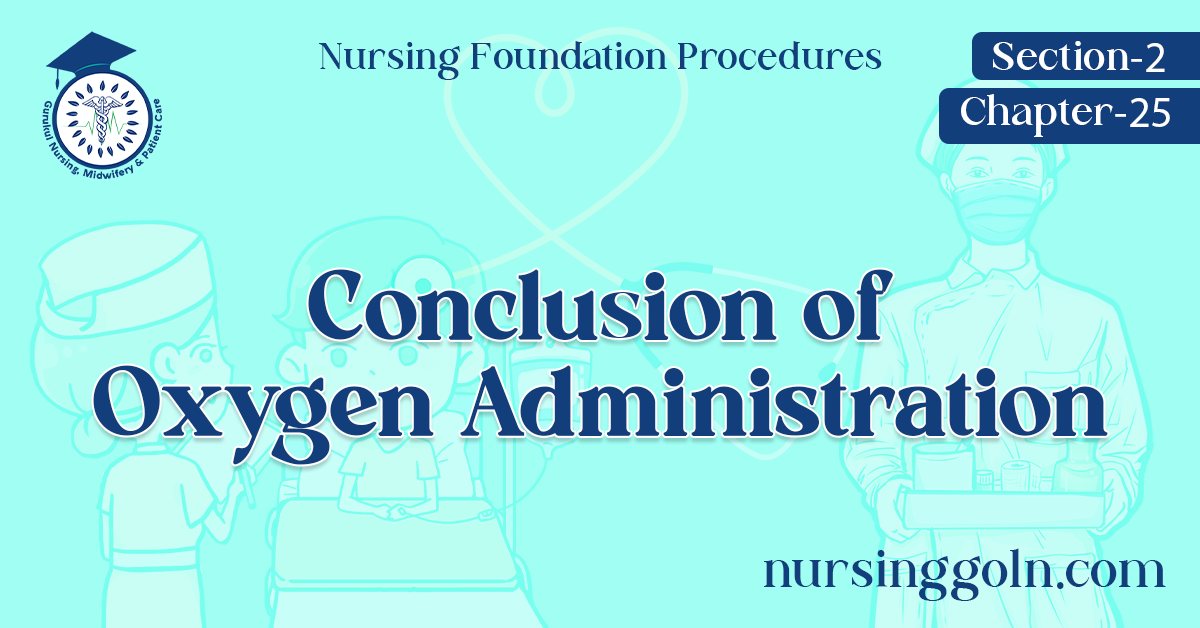Today our topic of discussion is Conclusion of Oxygen Administration . Oxygen, the life-sustaining gas that is crucial for the survival of aerobic organisms, plays a pivotal role in clinical medicine. Oxygen therapy, which refers to the provision of oxygen at concentrations higher than that of room air, has become a mainstay in the management of various medical conditions. Yet, like any other medical intervention, it’s essential to appreciate the rationale, benefits, and potential complications to administer it safely and effectively.
Conclusion of Oxygen Administration

CONCLUSION
Oxygen therapy can be lifesaving, but nurses must know how it works, when to use it, and how to correctly assess and evaluate a patient’s treatment. The need for oxygen therapy arises when oxygen transport to the tissues is insufficient due to a breakdown in either the respiratory or circulatory systems.

The aim of oxygen therapy is to maintain tissue oxygenation at a functional level, to eliminate detrimental compensatory responses to hypoxemia, which may cause serious or irreparable damage to vital organs and tissues. Oxygen is considered a drug and must, therefore, be prescribed by an appropriate clinician.

This would normally take the form of a formal prescription by a doctor, but may, in emergency lifesaving situations be administered by nurses operating oxygen system. Oxygen is a very combustible material, so it is important that correct guidelines are followed when storing or transporting oxygen cylinders.
Rationale for Oxygen Administration
The primary reason to administer supplemental oxygen is to treat or prevent hypoxemia, a condition characterized by reduced levels of oxygen in the blood. Inadequate oxygenation can adversely affect the function of vital organs such as the brain, heart, and kidneys. Ensuring optimal oxygen levels helps to maintain the function of these organs and, in many situations, can be life-saving.
Indications for Oxygen Therapy
Oxygen therapy is indicated in various clinical scenarios:
- Acute scenarios: Conditions like acute myocardial infarction (heart attack), stroke, shock, severe trauma, pulmonary embolism, and acute respiratory distress syndrome (ARDS).
- Chronic conditions: Chronic obstructive pulmonary disease (COPD), cystic fibrosis, interstitial lung disease, and severe heart failure.
- Preventative situations: During surgeries and to prevent the descent of oxygen levels during sleep in conditions like obstructive sleep apnea.
Modes of Oxygen Administration
Oxygen can be delivered in various ways:
- Nasal Cannula: Suitable for patients requiring low to medium levels of supplemental oxygen. It’s comfortable and allows for eating and talking.
- Face Masks: These can deliver higher oxygen concentrations. There are simple face masks, venturi masks, and non-rebreather masks.
- High-flow nasal cannula (HFNC): Delivers warmed and humidified oxygen at high flow rates, beneficial for patients with acute respiratory failure.
- Mechanical Ventilation: For patients who cannot breathe on their own. It can be invasive (endotracheal intubation) or non-invasive (like CPAP and BiPAP).
Benefits of Oxygen Therapy
- Improved Oxygenation: The most apparent benefit is the increase in blood oxygen levels, ensuring that organs receive the necessary oxygen for proper function.
- Reduced Work of Breathing: In conditions like COPD, where patients struggle to breathe, supplemental oxygen can reduce the effort required for each breath.
- Decreased Strain on the Heart: The heart doesn’t have to work as hard to deliver oxygen to the tissues, reducing the risk of complications like myocardial infarction.
Potential Complications and Their Prevention
Like any therapeutic intervention, oxygen therapy is not devoid of risks:
- Oxygen Toxicity: Breathing high concentrations of oxygen for prolonged periods can lead to lung complications, including inflammation and scarring.
- Hyperoxia: Excessive oxygen levels can lead to constriction of the cerebral blood vessels, potentially leading to decreased brain perfusion.
- CO2 Retention: In some COPD patients, high oxygen levels can suppress the drive to breathe, leading to carbon dioxide accumulation, a condition termed as hypercapnia.
To prevent these complications:
- Monitor: Continuous monitoring of oxygen saturation and blood gases is crucial. It ensures that the patient is receiving the right amount of oxygen.
- Titrate: Oxygen should be given at the lowest effective dose. Once the patient’s condition stabilizes, the amount of supplemental oxygen should be gradually reduced.
- Patient Education: Informing patients about the potential risks and benefits allows them to report any discomfort or potential side effects promptly.
Recent Advancements in Oxygen Therapy
Modern medicine has seen significant advancements in how we deliver and monitor oxygen therapy:
- Pulse Oximetry: A non-invasive method to continuously monitor oxygen levels in the blood.
- Portable Oxygen Concentrators: Allow patients with chronic conditions to remain mobile and active, improving their quality of life.
- Liquid Oxygen Systems: These systems offer a longer duration of oxygen supply and are more compact than traditional compressed gas systems.
Future of Oxygen Therapy
The field of oxygen therapy is ripe for innovation. With advances in technology, we might see:
- Smart Systems: Integration of AI and machine learning to adjust and deliver the exact amount of oxygen needed by the patient in real-time.
- Improved Interfaces: Masks and cannulas that are more comfortable, adaptable, and less obtrusive.
- Telemedicine: Remote monitoring of patients on oxygen therapy, ensuring timely intervention if problems arise.

Oxygen therapy, when appropriately administered, is a powerful tool in the armamentarium of healthcare providers. Its role in alleviating symptoms, improving organ function, and saving lives is undeniable. However, it is a double-edged sword. While it offers life-saving benefits, it comes with potential complications. The onus is on clinicians to strike the right balance—ensuring that patients receive the benefits of oxygen therapy without facing its potential adverse effects.
The evolution of oxygen administration methods and monitoring tools has dramatically enhanced our ability to provide optimal care. Yet, the foundation remains rooted in a thorough understanding of the therapy’s principles, vigilant monitoring, and a patient-centric approach. As we look forward, the horizon of oxygen therapy promises even more refined tools and methodologies, further enhancing our capability to deliver precise, effective, and safe care to those in need.
Read more:
